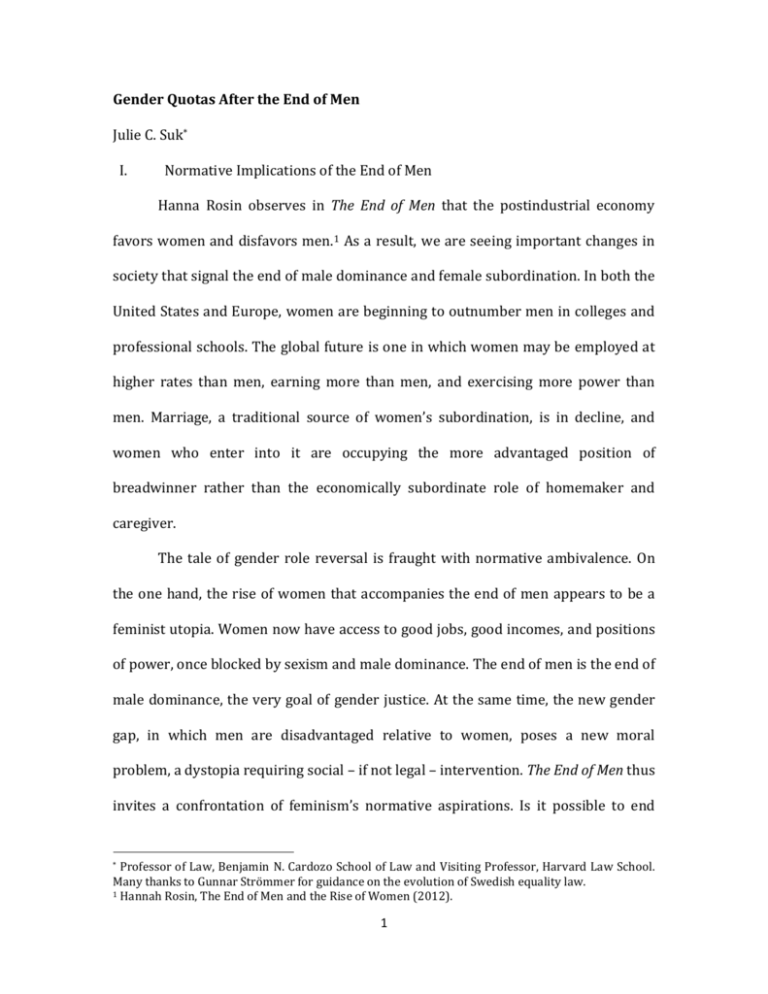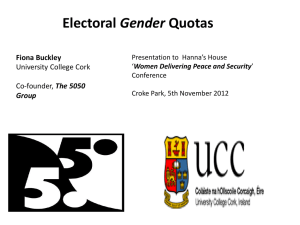Julie C. Suk
advertisement

Gender Quotas After the End of Men Julie C. Suk* I. Normative Implications of the End of Men Hanna Rosin observes in The End of Men that the postindustrial economy favors women and disfavors men.1 As a result, we are seeing important changes in society that signal the end of male dominance and female subordination. In both the United States and Europe, women are beginning to outnumber men in colleges and professional schools. The global future is one in which women may be employed at higher rates than men, earning more than men, and exercising more power than men. Marriage, a traditional source of women’s subordination, is in decline, and women who enter into it are occupying the more advantaged position of breadwinner rather than the economically subordinate role of homemaker and caregiver. The tale of gender role reversal is fraught with normative ambivalence. On the one hand, the rise of women that accompanies the end of men appears to be a feminist utopia. Women now have access to good jobs, good incomes, and positions of power, once blocked by sexism and male dominance. The end of men is the end of male dominance, the very goal of gender justice. At the same time, the new gender gap, in which men are disadvantaged relative to women, poses a new moral problem, a dystopia requiring social – if not legal – intervention. The End of Men thus invites a confrontation of feminism’s normative aspirations. Is it possible to end Professor of Law, Benjamin N. Cardozo School of Law and Visiting Professor, Harvard Law School. Many thanks to Gunnar Strömmer for guidance on the evolution of Swedish equality law. 1 Hannah Rosin, The End of Men and the Rise of Women (2012). * 1 male dominance and female subordination without engendering female dominance and male subordination? If the end of men does not amount to the oppression of men, is there anything unjust or normatively undesirable about allowing women to surpass men in income, employment, and power? In many jurisdictions around the world, women’s past and current disadvantage is regarded as an injustice that must be corrected by various measures, including antidiscrimination law, affirmative action, and even gender quotas. A large number of countries around the world have implemented electoral gender quotas, and many European countries have recently passed laws requiring corporate boards to implement gender quotas for their boards of directors. Under these quotas, no gender is permitted to exceed 60 percent of the desired positions. In the “end of men” future, men will benefit, and women will lose out, under such quotas. Will gender justice require – or even permit – gender quotas after the “end of men”? This paper engages this question by contrasting the constitutionalization in recent years of gender quotas in France, and the concurrent drive to end university gender quotas in Sweden. I assume that Rosin is correct in predicting the end of men, while understanding that the descriptive thesis is itself very contestable.2 Whether the end of men is coming or not, imagining such a universe is nevertheless useful for teasing out the fundamental commitments of gender justice, which will guide the law of gender equality today. 2 Indeed, many of the contributions to this symposium raise substantial questions about whether we are in fact approaching the “end of men” future. See contributions by Michael Selmi, Naomi Cahn & June Carbone. 2 II. The Rise of Gender Quotas As of November 2012, the European Commission has proposed a directive imposing gender quotas on the boards of directors of large publicly traded companies in Europe.3 The proposed directive provides: Member States shall ensure that listed companies in whose boards members of the under-represented sex hold less than 40 per cent of the non-executive director positions make the appointments to those positions on the basis of a comparative analysis of the qualifications of each candidate, by applying pre-established, clear, neutrally formulated and unambiguous criteria, in order to attain the said percentage at the latest by 1 January 2020 or at the latest by 1 January 2018 in case of listed companies which are public undertakings.4 Gender quotas have been widely used in European nations as well as other parts of the world to increase the number of women in various domains of power, especially legislatures.5 In 2011, several European countries adopted gender quotas for corporate boards,6 following Norway’s 2003 statute.7 The new gender quotas are not designed merely to require that the number of women meet a minimum threshold; they are gender parity rules framed in gender-neutral terms such that See European Commission, Proposal for a Directive of the European Parliament and the Council on improving the gender balance among non-executive directors of companies listed on stock exchanges and related measures, 2012/299 (COD). 4 Id., art. 4. 5 See Drude Dahlerup, Introduction, in Women, Quotas, and Politics 3 (2006); see generally Mona Lena Krook, Quotas for Women in Politics: Gender and Candidate Selection Worldwide (2009). 6 See Law 2011-103 du 27 janvier 2011 relative à la représentation équilibrée des femmes et des hommes au sein des conseils d’administration et de surveillance et à l’égalité professionnelle (1), Journal Officiel de la République Française [Official Gazette of France] [J.O.], Jan. 27, 2011, at 1680 (Fr.) ; Legge 12 Luglio 2011, n. 120/2011 Modifiche al testo unico delle disposizioni in material di intermediazione finanziaria, di cui al decreto legislative 24 febbraio 1998, no. 58, concernenti la parità di acceso agli organi di amministrazione e di controllo delle società quotate in mercati regolamentati, Gazzetta Ufficiale [Official Gazette of Italy] N. 174 del 28 Luglio 2011 (It.); Proposition de loi visant à promouvoir une representation équilibrée des femmes et des hommes dans les conseils d’administration d’entreprises publiques économiques et de societies qui on fait publiquement appel à l’épargne, Sénat de Belgique, Document legislative no. 5-186-2 (Feb.1, 2011) (Be.) (adopted June 30, 2011); Act to Amend Book 2 of the Dutch Company Act, Staatsblad [Official Gazette] 2011, no. 275, June 14, 2011 (Netherlands). See generally European Commission, Women in economic decision-making in the EU: Progress report 13 (2012). 7 Amendment to the Public Limited Companies Act, Ot.prp. No. 97 (2002−2003) (Nor.). 3 3 one sex can never become overrepresented.8 The most common formulation, like the European Commission proposal, is a rule prohibiting one sex from exceeding 60 percent of the positions to which the quota applies. In many of the European countries that have adopted gender quotas, gender balance (fifty-fifty equilibrium between men and women) is considered a worthwhile normative goal, a desirable and permanent feature of all just and equal institutions. The corporate board gender quotas that have emerged in the last couple of years are perhaps the logical extension of a more established global trend of gender quotas in electoral laws.9 Around 40 countries in Europe, Latin America, Africa, and Asia have introduced gender quotas for candidates for elected office. 10 In 50 other countries, political parties have been using gender quotas, though not required to do so by law, 11 in order to ensure that women are represented in government. These laws have been more successful in producing gender-balanced political bodies in some countries than in others.12 Success depends upon the electoral systems into which gender quotas are introduced, and the sanctions threatened or imposed for non-compliance with gender balance requirements. Cite, e.g.. Amendment to the Public Limited Companies Act, Ot.prp. No. 97 (2002−2003) (Nor.). Law 2011-103 du 27 janvier 2011 relative à la représentation équilibrée des femmes et des hommes au sein des conseils d’administration et de surveillance et à l’égalité professionnelle (1), Journal Officiel de la République Française [Official Gazette of France] [J.O.], Jan. 27, 2011, at 1680 (Fr.). 9 See Julie C. Suk, Gender Parity and State Legitimacy: From Public Office to Corporate Boards, 10 I*CON 449 (2012). 10 Dahlerup, supra note __, at 3. 11 Id. 12 In France, for instance, despite the electoral gender quota applicable to political parties since 2000, the French parliament remains 26.9 percent women as of July 2012. See Women in National Parliaments, Inter-Parliamentary Union. This falls far short of the 50-50 gender balance aspiration of the law. http://www.ipu.org/wmn-e/classif.htm. By contrast, in Norway, the corporate board gender quotas led to a rapid increase in the number of women on the boards of the companies to which the law applied. According to Norway’s official statistics as of January 2011, women constitute 40.1 percent of the boards of public limited companies, whereas men make up 59.9 percent. Norway statistics http://www.ssb.no/styre_en/tab-2011-06-07-01-en.html 8 4 In the various contexts in which gender quotas have been introduced, multiple justifications have emerged. Initially, supporters of gender quotas framed them as a measure to counteract the disadvantages faced by women in the domains in which they have been adopted. Quotas were recommended by the United Nations Decade for Women conference in 1975. The United Nations Convention on the Elimination of All Forms of Discrimination Against Women (CEDAW) urges state parties to “take all appropriate measures to eliminate discrimination against women by any person, organization or enterprise.”13 In addition article 4 of CEDAW explicitly states that “temporary special measures aimed at accelerating de facto equality between men and women shall not be considered discrimination as defined in the present Convention.”14 By 1995, the Platform for Action that emerged from the U.N. World Conference on Women in Beijing in encouraged “specific targets and implementing measures” to remove barriers that directly or indirectly discriminate against the participation of women.15 The jurisprudence of the European Court of Justice also strengthened the antisubordination rationale for gender quotas. In the 1990s, some private and public entities within the European Union had employment policies that could be described as gender quotas, which were challenged by male litigants. It was alleged that gender quotas violated the equal treatment directive.16 In Kalanke v. Freie CEDAW art. 2.1 CEDAW art. 4. For an account of the international legal origins of the French gender quotas proposals, see Eléonore Lépinard, L’égalité introuvable: la parité, les feminists, et la république pin (2007). 15 United Nations, Fourth World Conference on Women, Beijing Declaration and Platform for Action 1995, Strategic Objective G-1.p 16 See Equal Treatment Directive of 1976, 76/207/EEC. This directive implemented the principle of equal treatment between men and women in employment Since then, the Equal Treatment Directive has been 13 14 5 Hansestadt Bremen, the ECJ invalidated an employer’s policy of giving preference to female candidates for jobs in which women were under-represented (defined as under 50%) when choosing between equally qualified candidates. The ECJ referred to this policy as a “quota system.” While acknowledging that the Directive permitted different treatment of men and women within “measures to promote equal opportunity for men and women, in particular by removing existing inequalities which affect women’s opportunities,”17 Kalanke held that this exception must be construed narrowly, such that giving automatic priority to female candidates under these circumstances violated the equal treatment requirement. However, after Kalanke, the ECJ upheld a similar policy in 1997 in Marschall v. Land Nordrhein-Westfalen. The rule gave priority to women in promotions for any sector in which there were fewer women than men in the particular higher grade post, provided the male and female candidates had equal qualifications. The ECJ distinguished this case from Kalanke because the policy at issue in Marschall explicitly stated that women were not to be given priority if there were reasons specific to an individual male candidate that tilted the balance in his favor. 18 In elaborating its decision, the court pointed out that national measures that “give a specific advantage to women with a view to improving their ability to compete on the labour market and to pursue a career on equal footing with men”19 came within the positive action provision of the directive. amended and consolidated with other directives addressing equal pay and occupational social security schemes. See Equal Treatment Directive 2006/54/EC. 17 See Case C-450/93, Kalanke v. Freie Hansestadt Bremen, 1995 (citing Directive 76/207 EEC, art. 2(4)). 18 See Case C-409/95, Hellmut Marschall v. Land Nordrhein Westfalen, 1997. 19 Id. 6 In 2000, the ECJ upheld a German regional government’s “Women’s Advancement Plan,” which had set binding targets for women’s appointments and promotions to increase the proportion of women in sectors in which women were under-represented.20 In so doing, the court noted that qualified female candidates were less likely to be promoted “particularly because of prejudices and stereotypes concerning the role and capacities of women in working life, so that the mere fact that a male candidate and a female candidate are equally qualified does not mean they have the same chances.”21 It held that the Equal Treatment directive, and particularly the positive action provision, “does not preclude a national rule which, in so far as its objective is to eliminate underrepresentation of women, in trained occupations in which women are underrepresented and for which the State does not have a monopoly of training, allocates at least half the training places to women.”22 Quotas are a departure from the fundamental norm of equal treatment, subject to justification only if they remove barriers to women’s opportunities. The exception in the 1976 Equal Treatment directive was framed in gender-specific terms, wherein positive action to remove women’s disadvantage is justified, with silence on the question of positive action to remove men’s disadvantage.23 Furthermore, the ECJ made clear in another case decided the same year that the positive action provision of the directive did not permit a preference for female candidates (whether done Case C-158/97, Georg Badeck and Others v. Landesanwalt beim Staatsgerichtshof des Landes Hessen, 2000. 21 Id. at paragraph 21. 22 Id. at paragraph 55. 23 Nonetheless, the Equal Treatment directive of 2000 has a gender-neutral provision that permits “maintaining or adopting specific measures to prevent or compensate for disadvantages linked to any of the grounds.” Council Directive 2000/78/EC of 27 November 2000 establishing a general framework for equal treatment in employment and occupation, art. 7. 20 7 through a quota or a soft affirmative action scheme) whose qualifications were significantly and objectively inferior to a male candidate.24 Thus, the ECJ’s jurisprudence has reinforced the notion that the gender quotas can only be narrowly justified by the goal of eradicating women’s disadvantage. Particularly when women’s underrepresentation in certain positions is explained by prejudice, stereotype, or other practices associated with women’s traditional exclusion from working life, quotas tend to be upheld. Quotas are a mechanism for combating and undoing the history and present complex structures of women’s subordination. On this account of quotas, quotas are presumably no longer necessary nor legitimate once women’s under-representation is overcome. III. Gender Balance as a Permanent Goal: Parity Democracy in France However, throughout the 1990s, a new discourse emerged in continental Europe: Gender parity – the representation of men and women in roughly equal numbers – was understood to be a requirement of all legitimate institutions exercising power in a democracy because each sex represented half of humanity. Thus conceived, gender balance is not merely a means of eradicating women’s past disadvantage or current societal discrimination, but a permanent feature of good governance. Accordingly, legitimate legislatures and corporate boards must remain gender-balanced, even after women’s subordination has been alleviated. The alternative discourse emerged in France, in part because the French Constitutional Council had rejected a gender quota that had been proposed to 24 See Abrahamsson v. Foquelvist, Case C-407/98. 8 diminish women’s disadvantage in politics. In 1982, a proposed law would have required women to constitute 25% of the candidates for certain municipal elections.25 The Constitutional Council held that such a rule violated Article 3 of the French Constitution. At the time, Article 3 provided: National sovereignty shall belong to the people, who shall exercise it through their representatives and by means of referendum. No section of the people nor any individual may arrogate to itself, or to himself, the exercise thereof. Suffrage may be direct or indirect as provided by the Constitution. It shall always be universal, equal and secret. All French citizens of either sex who have reached their majority and are in possession of their civil and political rights may vote as provided by statute.26 This constitutional provision envisions national sovereignty as indivisible. Thus, dividing the electorate into sections or factions impedes the exercise of sovereignty. The Constitutional Council also invoked Article 6 of the French Declaration of the Rights of Man, which has constitutional status. Article 6 is essentially an equal protection guarantee, and it guarantees merit-based individual consideration, unlike its American counterpart: “All citizens, being equal in the eyes of the law, shall be equally eligible to all high offices, public positions and employments, according to their ability, and without other distinction than that of their virtues and talents.”27 The Constitutional Council held that a “combined reading” of these two provisions necessitated the invalidation of the gender quota, because “these constitutional principles preclude any division of persons entitled to vote or stand for election into 25. Law No. 82-974 of Nov. 19, 1982, Journal Officiel de la Republique Francaise [J.O.] [Official Gazette of France], Nov. 20, 1982, at 3487 (statute imposing quotas). 26 Const., art 3 (Fr. 1982), quoted in Conseil constitutionnel, 82-146DC, para. 6. 27 Declaration of the Rights of Man and of the Citizen, art. 6 (Fr. 1789). 9 separate categories.”28 Making distinctions of sex for the candidates for office would constitute such a division and thereby violate these two provisions. In response, the French advocates of gender quotas adopted a new strategy and a new discourse. The foundational text of the feminist parity movement, “Au pouvoir citoyennes! Liberté, Egalité, Parité” (“Towards Power, Female Citizens! Liberty, Equality, Parity”), proposed that parity, unlike quotas, aspired to vindicate the universality of the entire republic, rather than to remedy the disadvantage of one part of the population. Parity, unlike quotas, reaffirmed the unity (rather than division) of the republic by requiring that the two complementary halves of humanity (male and female) be represented.29 By contrast, quotas — understood as a low minimum threshold (e.g. 15-25%) -- served primarily to give women opportunities to compete for desired positions of power, to defend their special interests. The 25% quota treated women as a minority group with interests that may be at odds with the rest of the republic; hence it was divisive. On the other hand, “parity democracy” — understood as fifty-fifty male-female representation in all organizations exercising power in a democratic society — is not primarily aimed at enhancing women’s opportunities as individuals or even as a group. Its primary purpose is to legitimize the larger institution’s exercise of political, economic, and social power. The larger institution – the democratic republic – must represent the people, and all people are male or female. The new model embraced gender balance Decision 82-146 DC OF 18 November 1982 Act amending the Electoral Code and the Code of Municipalities and governing the election of municipal councillors and the conditions for entry of French nationals residing outside France in electoral registers 29. Françoise Gaspard, Claude Servan-Schreiber, Anne LeGall, Au pouvoir, citoyennes !: Liberté, égalité, parité 166 (1992) 28 10 as a collective democratic goal rather than as a means of achieving equal opportunity for a minority group.30 It also envisioned the fifty-fifty gender equilibrium as a permanent feature of any just governing body of the state. Democratic governance could not claim to be universal or legitimate if half of humanity were not represented. In France, the parity democracy ideal has become constitutionalized in recent years. In 1999, Article 3 of the constitution was amended with the following language: “The law favors the equal access of men and women to electoral power and elected positions.”31 In 2000, a new statute required party lists for municipal, regional, European, and Senatorial elections (those governed by the proportional representation system) to include an equal number of women and men candidates. When the French legislature attempted to legislate a gender parity rule for corporate boards of directors in 2006,32 the Constitutional Council struck it down, invoking Article 6 of the Declaration of Rights of Man.33 The Constitutional Council held that the 1999 amendment on “equal access by men and women to elected office” only spoke to parity quotas in elected office, and had not authorized such quotas in any other domain. The legislature reacted with yet another constitutional amendment. In 2008, the French constitution was amended to be consistent with the legislative proposal to impose gender quotas on corporate boards of directors. This time, the amendment was broad in language and scope. The constitutional 30. See generally Eléonore Lépinard, L’inégalité introuvable: La parité, les féministes et la république 158-85 (2007). 31 Loi constitutionnelle no. 99-569 du 8 juillet 1999 relative à l’égalité entre les hommes et les femmes, JORF du 9 juillet 1999, page 10175, art. 1 (Fr.). 32 Assemblé Nationale, Texte adopté no. 545, Projet de loi relatif à l’égalité salariale entre les hommes et les femmes, 23 février 2006. 33 Conseil constitutionnel, Décision no. 2006-533DC du 16 mars 2006. 11 amendment in 2008 added “positions of social and professional responsibility” to the paragraph added in 1999, and moved the entire provision to article 1 of the constitution. Article 1 now reads as follows: France shall be an indivisible, secular, democratic and social Republic. It shall ensure the equality of all citizens before the law, without distinction of origin, race or religion. It shall respect all beliefs. It shall be organized on a decentralized basis. Statutes shall favor equal access by women and men to elective offices and posts as well as to positions of professional and social responsibility. The amendment encourages, if not requires, the state to promote gender parity as fundamental constitutional law, by placing it in a constitutional article that establishes the principles legitimating the republic itself.34 Once the constitution was amended, the legislature was able to adopt, in 2011, a statute very similar to the one that had been struck down in 2006, requiring corporate boards of directors of publicly traded companies to achieve gender balance such that no gender can occupy more than 60 percent of the directorships. The constitutional amendments that enabled parity quotas were framed as “equal access,”35 but the 2011 statute imposing a parity quota on corporate boards of directors is styled as a law requiring “balanced representation of men and women.”36 In short, the law now defines gender equality as gender balance. Whereas a 25 percent women’s quota to alleviate women’s disadvantage violated constitutional equality provisions, a quota that requires women to constitute half or Some politicians expressed concern that the gender equality provision did not belong in Article 1, because Article 1 is a description of the nature of the republic itself. See Sénat, Séance du 18 juin 2008 (compte rendu intégral des débats), available at http://www.senat.fr/seances/s200806/s20080618/s20080618007.html 35 See Loi constitutionnelle no . 99-569, supra note __; Loi constitutionnelle no. 2008-724, supra note __. 36 Loi no. 2011-103, supra note __. 34 12 almost half of the decisionmaking bodies is consistent with those equality provisions (which have not been repealed), because gender balance has become the mechanism by which power is legitimized and equal access to decisionmaking is measured. One difficulty for the French advocates of gender parity was the question of whether gender quotas would lead to the adoption of race or ethnic quotas. Feminist advocates of gender parity insisted that gender was unlike race because sex was a universal, natural, and enduring feature of humanity.37 Women have always constituted (roughly) half of humanity and always will. There were men and women two millennia ago, and there will be men and women two millennia from now. It is hard to tell the same story for race. This rhetoric sounds like biological sex essentialism. The difference between men and women is understood to be “natural,”38 not contingent or political, whereas the difference between blacks and whites is understood to be socially (and legally) constructed. Parity democracy treats gender balance as a permanent goal of legitimate institutions, rather than as a remedy for discrimination against women that will expire once this discrimination has been eradicated. Under a “parity democracy” paradigm, the legislature’s legitimacy is compromised any time one gender becomes demographically under-represented. Since humanity is understood to be half female and half male, the under-representation of men poses the same illegitimacy problems as the under-representation of women. If the utopian vision of gender See Sylviane Agacinski, Parity of the Sexes (1999). 38.See Laure Bereni & Eléonore Lepinard, “Les femmes ne sont pas une catégorie”: Les strategies de légitmiation de la parité en France, 54 Revue française de science politique 71 (2004). 37 13 relations is two different halves complementing one another, men’s disadvantage and underrepresentation is a dystopia that must be corrected for the same reasons that women’s underrepresentation and disadvantage must be corrected. IV. The End of Men and the End of Quotas: The Case of Swedish Universities Recent developments in Sweden pose a challenge to parity democracy. Roughly twenty years ago, gender quotas were challenged before the ECJ by men who would have ascended to positions of power but for those quotas. But Sweden provides a glimpse of the end of men future: In Sweden, litigation challenging gender quotas over the last ten years has been brought by women arguing that they are being denied positions they deserve because the quotas are protecting the opportunities of less-qualified men. The Swedish prohibition of sex discrimination emanates from various sources of antidiscrimination law. Section 5 of the Discrimination Act prohibits education providers from discriminating against students on any of the grounds protected by the statute39 (sex, transgender identity or expression, ethnicity, religion, disability, sexual orientation, age). Nonetheless, Section 6 explicitly authorizes affirmative action, by providing that the prohibition of discrimination in Section 5 does not prevent “measures that contribute to efforts to promote equality between women and men in admissions to education”40 The Swedish Discrimination Act imposes duties on employers and education providers to take “active measures” 39 40 Discrimination Act, Section 5 (SFS 2008: 567) (Sweden). Discrimination Act, Section 6. 14 to achieve the purposes of the statute.41 It explicitly requires education providers to elaborate a yearly plan that includes measures to “promote equal rights and opportunities for the children, pupils or students participating in or applying for the activities, regardless of sex, ethnicity, religion, or other belief, disability, or sexual orientation.”42 The current education provisions of the Discrimination Act are understood to encompass the provisions of an earlier statute known as the Equal Treatment of Students at Universities Act. Section 7 of this statute prohibits unfavorable treatment on the basis of sex, ethnic belonging, religion or other religious faith, sexual orientation, or disability.43 It also included the “active-measures” provisions of the Discrimination Act, wherein Section 3 required universities to undertake “goal-oriented work to actively promote the equal rights of students irrespective of sex, ethnic belonging, religion or other religious faith, sexual orientation or disability.”44 It also required universities to adopt an annual plan towards these goals.45 However, the statute makes an exception for different treatment based on the prohibited grounds when the treatment is “justified by a special interest that is manifestly more important than the interest of preventing discrimination at the university.”46 In addition, the Higher Education Act provides, “Equality between women and men shall always be taken into account and promoted in the operations Discrimination Act, ch. 3. Discrimination Act, ch. 3, section 16. 43 Equal Treatment of Students at Universities Act, section 7 (2001:1286) (Sweden). 44 Equal Treatment of Students at Universities Act, section 3 (2001:1286) (Sweden). 45 Id., Section 5. 46 Id., Section 7. 41 42 15 of higher education institutions.”47 Finally, the Higher Education Ordinance reiterates the gender equality provision of the Higher Education Act.48 It also states, “Provisions on the equal treatment of students and applicants to higher education institutions, irrespective of gender, ethnic belonging, religion or other belief, sexual orientation or disability, are given in the Equal Treatment of Students at Universities Act.”49 Within this legal landscape, some Swedish universities implemented gender quotas in their admissions procedures, requiring gender balance in the admitted class. As of 2009, 29 out of 35 Swedish universities were using some form of gender quota. These gender quotas were intended in part to undermine the gender segmentation in the subjects studied by men and women. Women are underrepresented, for instance, in the science disciplines. Despite women’s greater likelihood of finishing a college degree, women are underrepresented in research and academic careers. Quotas to achieve gender balance have generally been regarded as a measure to eradicate women’s disadvantage, as manifested in the underrepresentation of women in subjects that lead to more prestigious careers. But in practice, gender parity quotas in some university departments disadvantaged women in the admissions process. In recent years, litigation brought by the Swedish Centrum för rättvisa (Center for Justice), a public-interest organization, has successfully challenged gender quotas on behalf of female plaintiffs who have been denied university admission. The veterinary school at the Higher Education Act, ch. 1 section 5 (Sweden). See Higher Education Ordinance, ch. 1 Section 8 (SFS 1993:100) (Sweden). 49 Higher Education Ordinance, ch. 1 Section 9. 47 48 16 Swedish University of Agricultural Sciences had been using a gender quota in admissions. In Sweden, consistent with the Higher Education ordinance, admissions are based strictly on high school grades and/or test scores. Thus, under the admissions scheme at the veterinary school, the school’s attempt to achieve gender balance led to a situation in which female candidates who gained admission had higher scores than the male candidates who gained admission. The Centrum för rättvisa represented female students who had been denied admission to the program in a lawsuit alleging that this admissions scheme constituted direct discrimination in violation of Section 7 of the Equal Treatment of Students at Universities Act. The Svea Court of Appeals agreed, declining to regard this program as coming within the statutory exception for different treatment justified by special interests more important than preventing discrimination.50 The Centrum för rättvisa concurrently challenged a similar gender quota for admissions to the University of Lund’s Psychology department, on behalf of female plaintiffs who had been denied admission.51 Shortly after the Svea Court of Appeals’ decision in the veterinary case, the University of Lund settled the psychology admissions case.52 Although the Swedish Supreme Court has never ruled on the legality of gender quotas, it had ruled in 2005 that an ethnic quota for admissions to Uppsala Law Faculty violated the same provision of the Equal Treatment of Students at Universities Act. The Uppsala law faculty had been setting aside 10 percent of its spots for students born to two non-Swedish parents. The Swedish Supreme Court See Svea Court of Appeal, Case T 3552-09, Dec. 21, 2009. See Complaint of Elin Sahlin, Oct. 14, 2009 (on file with author). 52 See Female Students Awarded Discrimination Damages, The Local, Feb. 22, 2010. 50 51 17 held that this was a form of discrimination on the basis of ethnicity that could not be sustained as a valid exception to the equal treatment provision in Section 7 of the Equal Treatment of Students at Universities Act.53 Indeed, this ruling encouraged Centrum för rättvisa to begin litigating the challenges to gender quotas as well. In the wake of the litigation challenging race and gender quotas in Swedish Universities, the Swedish legislature took action in 2010 to prohibit quotas in university admissions as a general matter. The statute repealed the language in the higher education statute that had permitted exceptions to the requirement of equal treatment for different treatment that could be specially justified for manifestly important reasons. Accordingly, it is now understood that universities can no longer use quotas or other forms of gender-conscious action to achieve gender balance. In justifying the new ordinance, the Swedish Minister of Higher Education Tobias Krantz pointed out that the quota system “has hit the talented female students especially hard.”54 In the absence of quotas at in Swedish university admissions, it is predicted that women will outnumber men in 7 out of 9 fields of study, with men outnumbering women only in two technical fields.55 This is consistent with the overall situation in Europe. A European Commission report indicates that women between the ages of 20 and 24 are outperforming men in educational results in all Supreme Court of Sweden, Case T 400-06, Dec. 21, 2006. For a discussion of the case see Christopher McCrudden & Sacha Prechal, The Concepts of Equality and Non-Discrimination in Europe: A Practical Approach 40 (2009). 54 See Marte Ericcson Ryste, Sweden Ends Use of Preferential Treatment in Connection with University Entries, European Directory of Women and ICT, Aug. 25, 2010, available at http://www.ictwomendirectory.eu/digitalcity/projects/eudir/eudir_boxedNews.jsp?dom=AAAALJJS &prt=BAAEZMPO&firt=AAAAVDLJ&men=BAAEZMPQ&smen=BAAEZMPQ&fmn=BAAEZMQX. 55 See id. 53 18 the member states.56 Women now make up 59 percent of university graduates in Europe. Women are more heavily represented than men in most subjects, including competitive and prestigious subjects like medicine and law. More women than men are now studying some science subjects as well, such as biology and veterinary sciences.57 Nonetheless, men remain overrepresented in physical sciences and engineering.58 In Sweden, university gender quotas came to end because they were no longer needed to counteract women’s disadvantage in that particular context. Indeed, the government’s stated justification for repealing the provisions of law that left room for such quotas was that the policies were hurting talented women. The Swedish Ministry of Justice has opposed EU legislation requiring gender parity on corporate boards.59 In Sweden, the vision of gender justice that is being pursued does not require gender balance as a permanent feature of legitimate institutions. A society in which women are overrepresented in prestigious university programs that lead to prestigious jobs and positions of power is not necessarily an unjust one. According to the Swedish vision of equality that is now taking shape in the university context, an overrepresentation of women would only be problematic if it could be traced to the subordination of men or women. For instance, women are overrepresented in some professions, such as nursing and early childhood education, largely because these are professions closely connected to women’s See European Commission, DG for Employment, Social Affairs, and Equal Opportunities, Report on Equality Between Women and Men 16 (2009) (graph on Educational Attainment (at least upper secondary school) of women and men aged 20-24 in EU Member States, 2007). 57 See European Commission, Opinion on The Future of Gender Equality Policy After 2010, at 14. 58 Id. 59 Swedish Ministry of Justice, Gender imbalance in corporate boards in the EU – public consultation, 28 May 2012. 56 19 traditional subordinate role as caregivers. Gunnar Strömmer, the Centrum for rättvisa lawyer who represented the female plaintiffs in the Swedish university litigations, has questioned whether gender balance should always be a goal in itself. Nonetheless, he has acknowledged that “[f]or some study programmes, such as early childhood education and psychology, it might be important to educate both women and men. But why is it problematic that more women than men want to be veterinarians?”60 V. Conclusion: Toward a Feminism of Fear The recent trajectories of gender quotas in France and Sweden suggest a tension between the parity democracy and antisubordination rationales for gender quotas. In the domains where women remain disadvantaged or underrepresented, this tension remains masked, as the two rationales converge to support positive measures to eradicate women’s disadvantage. But in the domains where women are beginning to outperform men, should gender balance be manufactured? This question has direct relevance to the United States. Rosin notes that many American college admissions officers are avoiding “crossing the dreaded 60 percent threshold” by “explain[ing] away boys’ deficits.”61 This is an informal gender quota to slow down – or prevent – the end of men. Are American equality norms quietly moving from antisubordination to parity democracy? 60 See Marte Ericsson Ryste, Sweden ends the use of preferential treatment, Promoting Gender Equality, KILDEN, Information for Gender Research in Norway, Aug. 13, 2010, available at http://eng.kifinfo.no/nyhet/vis.html?tid=72920 61 Hanna Rosin, The End of Men and the Rise of Women 169 (2012). 20 The American version of parity democracy may amount to a feminism of fear, to borrow Judith Shklar’s defense of liberalism.62 For Shklar, the most compelling justification for liberal principles such as limited government was not the moral aspiration to individual freedom, but the avoidance of cruelty and physical suffering. The “liberalism of fear” did not offer a “summum bonum toward which all political agents should strive,” but rather, a “summum malum, which all of us know and would avoid if only we could.”63 Similarly, a feminism of fear would conceptualize gender balance not as the “summum bonum,” embraced by the French ideology of parité, but rather, as a safeguard against the “summum malum” of sex-based subordination. Even if male disadvantage in the post-industrial economy is not explained by women’s unjust subordination of men, gender balance can protect against the possibility of women exploiting their existing advantages to create greater, undeserved disparities, that endure beyond the post-industrial age. Today’s feminists may disagree about the precise historical moment at which men exploited their advantage in pre-industrial economies to produce the gender injustice against which modern feminists have struggled. Maintaining gender balance indefinitely, even in the absence of apparent sex-based subordination, provides a practical if imprecise way of doing equality without precisely defining the line between disadvantage and subordination. 62 63 Judith Shklar, The Liberalism of Fear, in Political Thought and Political Thinkers 2 (1998). Id. at 10. 21








